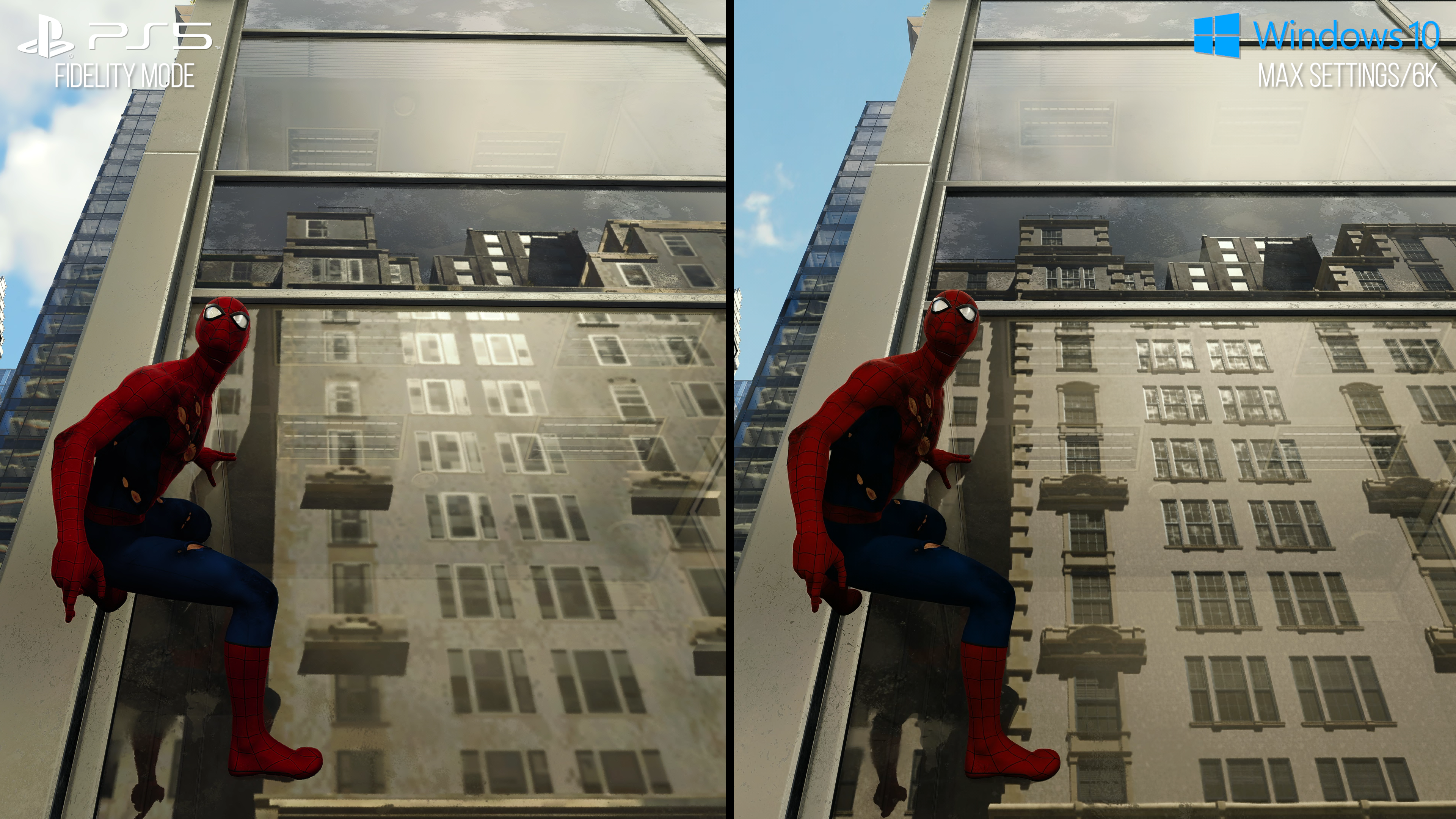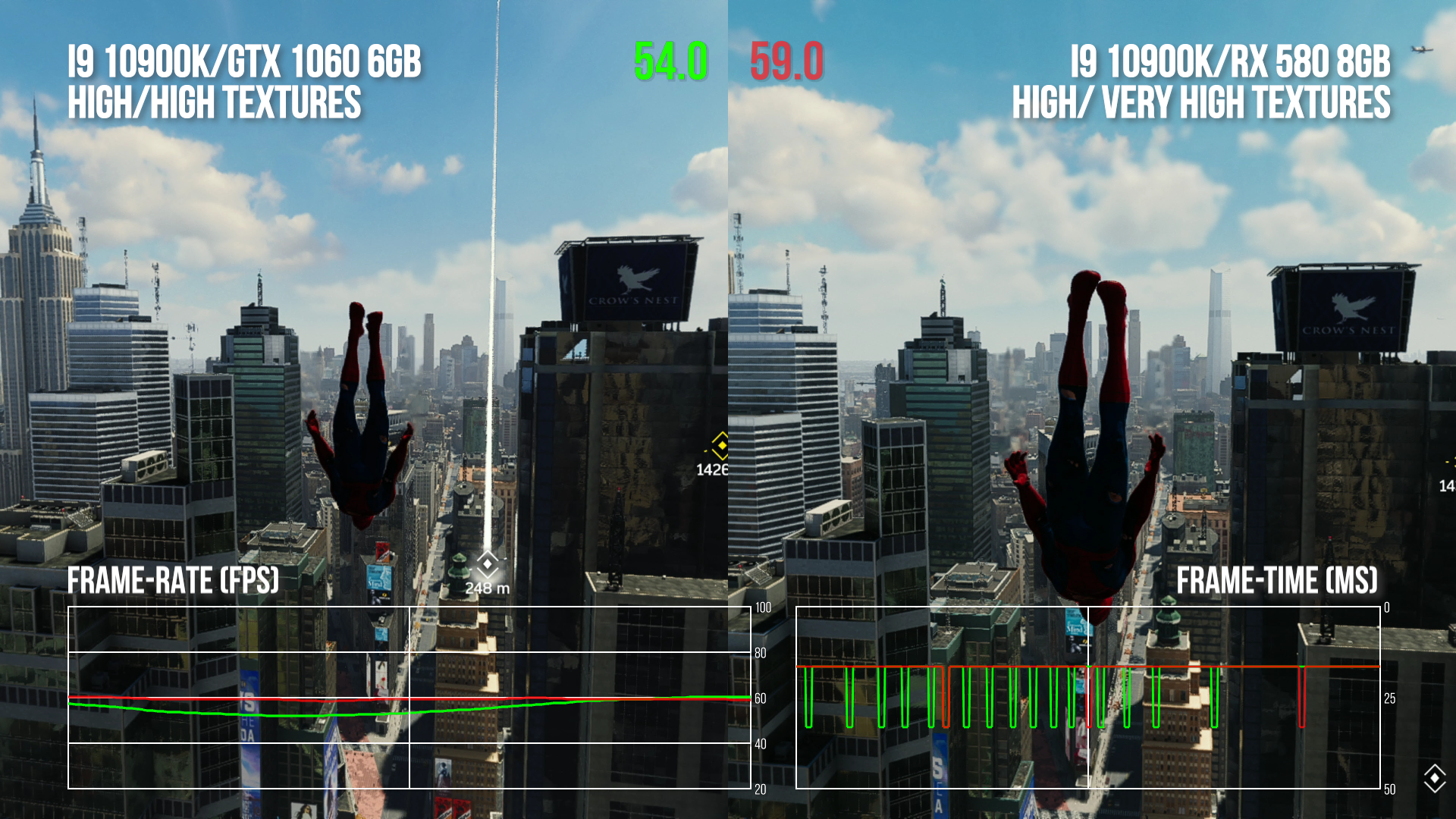Developer Nixxes patched Marvel’s Spider-Man a couple of hours before embargo on Wednesday, setting back our PC tech review, but the update was worth it and while a little more polish is required to get the game fully into shape, the release you’ll be playing today definitely hits the spot. We’ve already covered the PC version in broad brush strokes, but today we can get a little more granular and offer up our optimised settings for delivering the best balance between performance and fidelity.
Let’s quickly recap on what we’ve already discussed – and it’s mostly great stuff. First of all, I like the graphics configuration menu that appears before you run the game – it’s a Nixxes (and IO Interactive!) hallmark that gives you an instant ‘at a glance’ look at the options available and allows for friction-free settings changes outside of the game. Those settings include fully realised support for practically any aspect ratio, plus configurable field of view. Not only that, but the game’s full-screen support includes actual exclusive full-screen, allowing for resolutions and refresh rates outside of the desktop options – a rare thing in PC gaming today.
Also impressive is how the in-game options menu actually works. Pause the game at any time and any tweaks you make are instantly deployed, allowing you to see the changes you’ve made in real-time. In a world where some problematic PC titles don’t do this and can even require you to restart the game, this is excellent. On paper, all of the things I’ve praised here should be standard and second nature to PC developers but unfortunately that’s not the case. Where Nixxes excels is where ports like Elden Ring, Final Fantasy VII or Halo Infinite flounder, sometimes spectacularly so.
And what about my other current ‘bugbear’ with PC gaming? I refer, of course, to my #StutterStruggle, where the majority of major PC ports are now shipping with intrusive stuttering – often because of ‘just in time’ shader compilation, literally freezing the game as shaders are compiled as needed. Nixxes seems to avoid this issue entirely by compiling during loading and perhaps even asynchronously in the background as you play – the latter technique being how the team solved the intrusive stutter in Horizon Zero Dawn on PC.
The hallmark of a good PC port from consoles concerns scalability – both up and down. Ideally you’d want the game to run on a resource-constrained system like Steam Deck, while at the same time scaling up to the absolute high-end and beyond. First up, let’s talk about the PC version’s similarities with PS5. That starts with texture quality, which is mirrored between PS5 and PC – the very high preset representing the console in both performance and quality modes. The PS5 has a fair amount of memory, so choosing texture quality should be done carefully on PC. If you’ve got a 6GB GPU, stick to high textures, rising to 8GB for very high – but you might consider avoiding higher RT settings in this scenario. A GPU with 10GB or more should be good for anything the game throws at you, even with maxed out ray tracing features.
Another holdover from consoles concerns ambient occlusion. The game supports HBAO+ but it doesn’t seem well-suited to the game world – I recommend sticking with standard SSAO instead, which is a match for PlayStation 5. Maybe HBAO+ is not working correctly as of now, but for the moment, regardless of performance I recommend using SSAO. Moving on, depth of field is also matched between consoles and PC – the PS5 seemingly in the medium or high quality range. I’d actually choose the low option here as the performance win is substantial and the quality drop is minimal. Hair rendering quality? This concerns Insomniac’s beautiful new strand tech, as showcased here and in Ratchet and Clank – medium is just fine here, though PS5 actually runs at something akin to the high setting in fidelity mode. Medium could be game-changing for lower-end GPUs – dropping from high to medium is a massive performance win on Steam Deck, for example.
| PS5 Performance RT | PS5 Fidelity | PC Optimised Settings | |
|---|---|---|---|
| Texture Quality | High | High | High |
| Anisotropic Filtering | 4x | 4x | 8x |
| Shadow Quality | High | High | High |
| Ambient Occlusion | SSAO | SSAO | SSAO |
| RT Reflections Resolution | High | High | High |
| RT Reflections Geo Quality | High | High | High |
| RT Reflections Object Range | 7/8 | ~10 | 8 |
| Hair Quality | Medium-High | High | High |
| Level of Detail | High | High | High |
| Crowd Density | Low-Medium | Medium-High | Low |
| Traffic Density | Unknown | Unknown | Low |
| Depth of Field Quality | Medium/High | Medium/High | Low |
Beyond this, the game starts having tangible upgrades in its settings: image quality gets a big upgrade thanks to support for higher texture filtering quality levels, while DLSS, DLAA and FSR 2.0 can be used for both upscaling and for stabilising performance via dynamic resolution scaling. Other settings can be subtle: shadow quality is marginally improved, for example. However, there is scalability in level of detail, best experienced while on foot, though ramping up the setting will yield subtle improvements in distance object detail. Tangentially related to LOD are the settings for crowds and traffic, though opting for low here doesn’t remove too much from the presentation but does improve CPU and GPU performance significantly. I struggled to see any difference in the traffic setting at all, so with that in mind, I couldn’t nail down where Insomniac pitched PlayStation 5.
The biggest upgrade of all? Hardware-accelerated ray tracing support. I’m happy to see a range of granular settings here, but very high exceeds the high setting typically used by PS5. Building geometry boiled down into flat textures on consoles are fully modelled on PC, texture quality is on an altogether different level quality, while the amount of associated world detail – and shadows – also get fully reflected, sometimes where PS5 has no reflections at all. Nixxes also offers PC users the chance to push out draw distance on objects/crowds/traffic beyond the console standard – and that ties into the level of detail/crowd/traffic settings I’ve already discussed. Just remember that the more you push RT, the higher the load on both GPU and CPU.

Optimised settings are on the page in an easy-to-digest table, but ultimately, we’re looking at a variation of PlayStation 5’s performance RT mode. It’s not possible to match settings precisely, however, and I do wish that console equivalent presets were available to tweak from. Let’s put it this way: the crowd LOD setting in the performance RT mode does not correspond to any of PC’s offerings. Clearly, Insomniac made its selections carefully with a view to balancing cost vs fidelity, so why not offer PC users that setting?
The ‘original’ presets found in God of War and Horizon were very useful – they showed PC users where the original versions made their performance vs fidelity trade-offs and then allowed users to tweak from there. Fidelity, Performance and Performance RT selectable presets would’ve been very welcome here in the PC port. Still, on a Ryzen 5 3600 PC armed with an RTX 2060 Super, optimised settings gives you a 43 percent performance boost in the taxing Times Square – and as we may well be CPU limited there, the actual improvement may be higher still, depending on the balance of your rig.
We’ve discussed optimised settings based on a good ‘entry level’ RT capable GPU – the RTX 2060 Super – but what about GTX 1060 and the RX 580, Nvidia and AMDs’ most populous GPUs? Per our previous article, we had severe issues with these before the last patch but the situation has improved. It’s the city traversal that causes problems and I’d recommend a 60 frames per second frame-rate cap, with dynamic resolution scaling engaged. The GTX 1060 gets you a mostly locked 60fps, with occasional dips down to the mid-50s and a worst case scenario I’ve seen of around 49fps. The RX 580 is faster – add 5-6fps to the tally there.

Overall, it’s solid enough at high settings, but lowering presets won’t do much to improve remaining stutter – this is something Nixxes needs to look at. I found that moving up to GTX 1660 Ti gave a rock-solid 60fps. Recommended settings for Steam Deck? Stick with optimised settings but drop hair quality to medium and texture filtering to 4x. Cap to 30fps via the system limiter (not even very low settings will allow for a locked 40fps) but to be honest, dropping all high settings to medium bar texture quality saves a lot of performance and still looks superb on the handheld screen.
One final tip for users with older hardware: while it may not work on Steam Deck, the game’s own 30fps cap operates fine with consistent frame-pacing – select half refresh rate v-sync and you’re good to go. Obviously, this means a locked 30fps on a 60Hz screen while higher refresh displays will run at half whatever that update rate is, but it works well, so use it if needed.
Ultimately, this port has turned out beautifully and I’m happy with it – but the stuttering GPU utilisation during traversal on 1060/580 class hardware and likely lower is problematic, but I’m told that Nixxes is still looking at improving the situation still further. I also feel that the game is still somewhat CPU-heavy – and would like to see further optimisation there. Beyond that, we’re looking at a game that has transitioned gracefully across from console to PC, offering all of the quality of life improvements I’d like to see – and then some. I’d like to see easily accessible config.cfg files for tweaking (I’m not even sure where this file resides on PC, or whether there is one at all!) but at this point we’re veering hard into nit-pick territory – which demonstrates just how impressive this release actually is overall!




